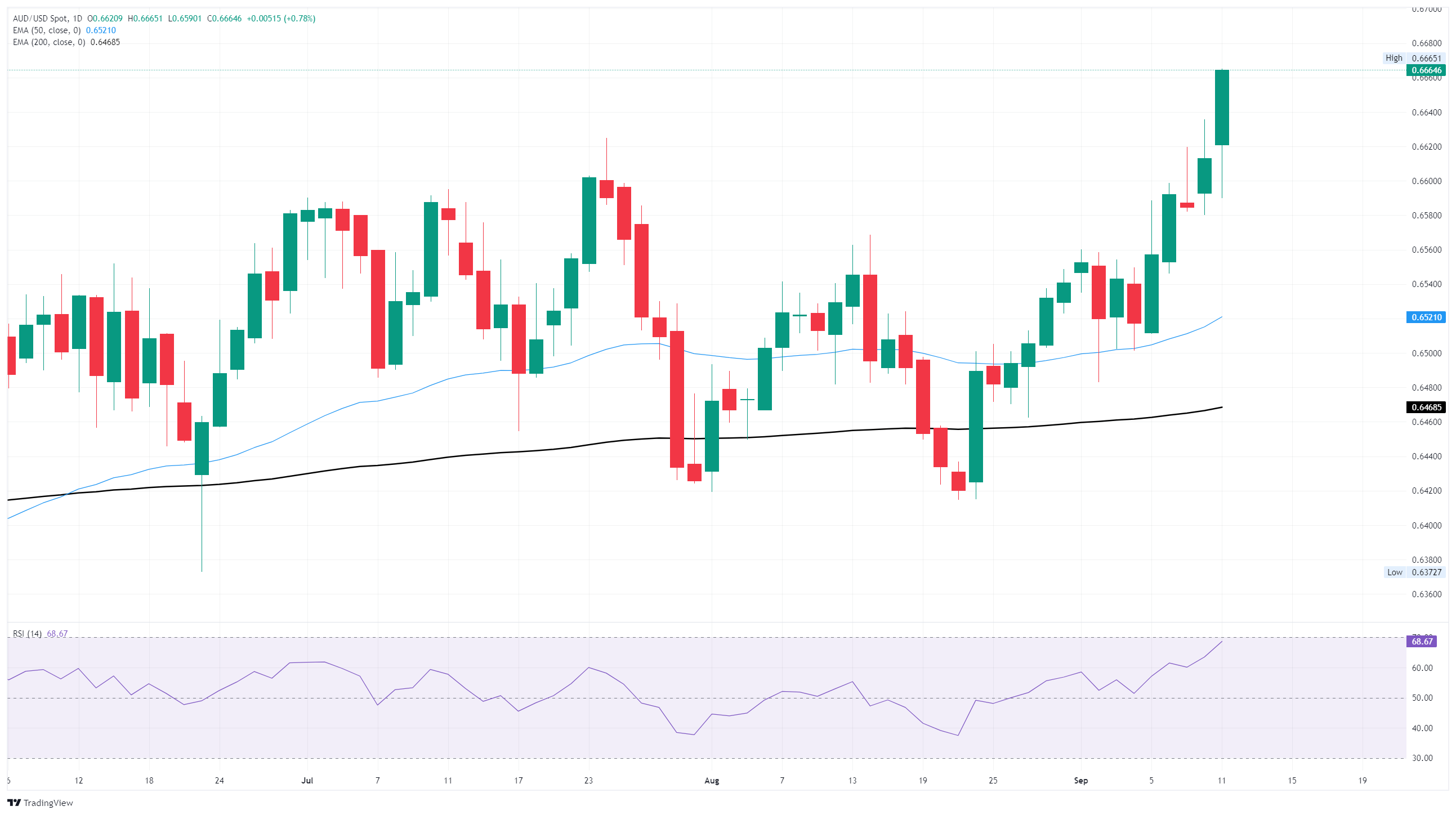AUD/USD touches new ten-month high as Greenback easing continues
- AUD/USD found strong support from 0.6600 on Thursday, bouncing into fresh highs near 0.6650.
- US CPI inflation rose in August, but not enough to derail Fed rate cut bets.
- Australian inflation expectations also remain elevated.
AUD/USD knocked into another new ten-month peak on Thursday, clocking in an intraday peak above 0.6650 for the first time since last November. The Australian Dollar (AUD) rose around three-quarters of one percent against the US Dollar (USD) for the day, bringing its latest bullish swing from its last swing low to nearly 4%. AUD/USD has risen over 3.8% from its late August low of 0.6414.
US Consumer Price Index (CPI) inflation rose again in August, with headline CPI inflation rising to 2.9% YoY, while core CPI inflation held steady at 3.1% YoY. Recent declines in gasoline prices are being offset by new price pressures in shelter and food costs, and the prices of consumer goods, including electronics and apparel, are rising as the Trump administration’s tariffs begin to bite consumers in their wallets.
US money markets have fully priced in three quarter-point rate cuts from the Federal Reserve (Fed) before the end of the year. The Fed is broadly expected to deliver an initial 25 bps rate cut at its rate meeting next week, with two more rate cuts fully priced in for the October and December Federal Open Market Committee (FOMC) meetings.
AUD/USD daily chart

Australian Dollar FAQs
One of the most significant factors for the Australian Dollar (AUD) is the level of interest rates set by the Reserve Bank of Australia (RBA). Because Australia is a resource-rich country another key driver is the price of its biggest export, Iron Ore. The health of the Chinese economy, its largest trading partner, is a factor, as well as inflation in Australia, its growth rate and Trade Balance. Market sentiment – whether investors are taking on more risky assets (risk-on) or seeking safe-havens (risk-off) – is also a factor, with risk-on positive for AUD.
The Reserve Bank of Australia (RBA) influences the Australian Dollar (AUD) by setting the level of interest rates that Australian banks can lend to each other. This influences the level of interest rates in the economy as a whole. The main goal of the RBA is to maintain a stable inflation rate of 2-3% by adjusting interest rates up or down. Relatively high interest rates compared to other major central banks support the AUD, and the opposite for relatively low. The RBA can also use quantitative easing and tightening to influence credit conditions, with the former AUD-negative and the latter AUD-positive.
China is Australia’s largest trading partner so the health of the Chinese economy is a major influence on the value of the Australian Dollar (AUD). When the Chinese economy is doing well it purchases more raw materials, goods and services from Australia, lifting demand for the AUD, and pushing up its value. The opposite is the case when the Chinese economy is not growing as fast as expected. Positive or negative surprises in Chinese growth data, therefore, often have a direct impact on the Australian Dollar and its pairs.
Iron Ore is Australia’s largest export, accounting for $118 billion a year according to data from 2021, with China as its primary destination. The price of Iron Ore, therefore, can be a driver of the Australian Dollar. Generally, if the price of Iron Ore rises, AUD also goes up, as aggregate demand for the currency increases. The opposite is the case if the price of Iron Ore falls. Higher Iron Ore prices also tend to result in a greater likelihood of a positive Trade Balance for Australia, which is also positive of the AUD.
The Trade Balance, which is the difference between what a country earns from its exports versus what it pays for its imports, is another factor that can influence the value of the Australian Dollar. If Australia produces highly sought after exports, then its currency will gain in value purely from the surplus demand created from foreign buyers seeking to purchase its exports versus what it spends to purchase imports. Therefore, a positive net Trade Balance strengthens the AUD, with the opposite effect if the Trade Balance is negative.

